+ Open data
Open data
- Basic information
Basic information
| Entry |  | |||||||||
|---|---|---|---|---|---|---|---|---|---|---|
| Title | Computational Designed Nanocage O43_129_+4 | |||||||||
 Map data Map data | deepEMhancer sharpened map | |||||||||
 Sample Sample |
| |||||||||
 Keywords Keywords | O43 / Nanocage / De Novo / Programmable Design / DE NOVO PROTEIN | |||||||||
| Biological species | unidentified (others) / synthetic construct (others) | |||||||||
| Method | single particle reconstruction / cryo EM / Resolution: 6.4 Å | |||||||||
 Authors Authors | Carr KD / Weidle C / Borst AJ | |||||||||
| Funding support |  United States, 1 items United States, 1 items
| |||||||||
 Citation Citation |  Journal: Nature / Year: 2024 Journal: Nature / Year: 2024Title: Blueprinting extendable nanomaterials with standardized protein blocks. Authors: Timothy F Huddy / Yang Hsia / Ryan D Kibler / Jinwei Xu / Neville Bethel / Deepesh Nagarajan / Rachel Redler / Philip J Y Leung / Connor Weidle / Alexis Courbet / Erin C Yang / Asim K Bera / ...Authors: Timothy F Huddy / Yang Hsia / Ryan D Kibler / Jinwei Xu / Neville Bethel / Deepesh Nagarajan / Rachel Redler / Philip J Y Leung / Connor Weidle / Alexis Courbet / Erin C Yang / Asim K Bera / Nicolas Coudray / S John Calise / Fatima A Davila-Hernandez / Hannah L Han / Kenneth D Carr / Zhe Li / Ryan McHugh / Gabriella Reggiano / Alex Kang / Banumathi Sankaran / Miles S Dickinson / Brian Coventry / T J Brunette / Yulai Liu / Justas Dauparas / Andrew J Borst / Damian Ekiert / Justin M Kollman / Gira Bhabha / David Baker /   Abstract: A wooden house frame consists of many different lumber pieces, but because of the regularity of these building blocks, the structure can be designed using straightforward geometrical principles. The ...A wooden house frame consists of many different lumber pieces, but because of the regularity of these building blocks, the structure can be designed using straightforward geometrical principles. The design of multicomponent protein assemblies, in comparison, has been much more complex, largely owing to the irregular shapes of protein structures. Here we describe extendable linear, curved and angled protein building blocks, as well as inter-block interactions, that conform to specified geometric standards; assemblies designed using these blocks inherit their extendability and regular interaction surfaces, enabling them to be expanded or contracted by varying the number of modules, and reinforced with secondary struts. Using X-ray crystallography and electron microscopy, we validate nanomaterial designs ranging from simple polygonal and circular oligomers that can be concentrically nested, up to large polyhedral nanocages and unbounded straight 'train track' assemblies with reconfigurable sizes and geometries that can be readily blueprinted. Because of the complexity of protein structures and sequence-structure relationships, it has not previously been possible to build up large protein assemblies by deliberate placement of protein backbones onto a blank three-dimensional canvas; the simplicity and geometric regularity of our design platform now enables construction of protein nanomaterials according to 'back of an envelope' architectural blueprints. | |||||||||
| History |
|
- Structure visualization
Structure visualization
| Supplemental images |
|---|
- Downloads & links
Downloads & links
-EMDB archive
| Map data |  emd_42944.map.gz emd_42944.map.gz | 159.6 MB |  EMDB map data format EMDB map data format | |
|---|---|---|---|---|
| Header (meta data) |  emd-42944-v30.xml emd-42944-v30.xml emd-42944.xml emd-42944.xml | 21.5 KB 21.5 KB | Display Display |  EMDB header EMDB header |
| FSC (resolution estimation) |  emd_42944_fsc.xml emd_42944_fsc.xml | 11.9 KB | Display |  FSC data file FSC data file |
| Images |  emd_42944.png emd_42944.png | 168.1 KB | ||
| Filedesc metadata |  emd-42944.cif.gz emd-42944.cif.gz | 6.4 KB | ||
| Others |  emd_42944_additional_1.map.gz emd_42944_additional_1.map.gz emd_42944_half_map_1.map.gz emd_42944_half_map_1.map.gz emd_42944_half_map_2.map.gz emd_42944_half_map_2.map.gz | 88.4 MB 164.6 MB 164.6 MB | ||
| Archive directory |  http://ftp.pdbj.org/pub/emdb/structures/EMD-42944 http://ftp.pdbj.org/pub/emdb/structures/EMD-42944 ftp://ftp.pdbj.org/pub/emdb/structures/EMD-42944 ftp://ftp.pdbj.org/pub/emdb/structures/EMD-42944 | HTTPS FTP |
-Validation report
| Summary document |  emd_42944_validation.pdf.gz emd_42944_validation.pdf.gz | 812 KB | Display |  EMDB validaton report EMDB validaton report |
|---|---|---|---|---|
| Full document |  emd_42944_full_validation.pdf.gz emd_42944_full_validation.pdf.gz | 811.5 KB | Display | |
| Data in XML |  emd_42944_validation.xml.gz emd_42944_validation.xml.gz | 20.1 KB | Display | |
| Data in CIF |  emd_42944_validation.cif.gz emd_42944_validation.cif.gz | 26.5 KB | Display | |
| Arichive directory |  https://ftp.pdbj.org/pub/emdb/validation_reports/EMD-42944 https://ftp.pdbj.org/pub/emdb/validation_reports/EMD-42944 ftp://ftp.pdbj.org/pub/emdb/validation_reports/EMD-42944 ftp://ftp.pdbj.org/pub/emdb/validation_reports/EMD-42944 | HTTPS FTP |
-Related structure data
| Related structure data | 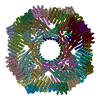 8v3bMC 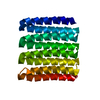 8g9jC 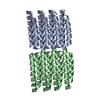 8g9kC  8ga6C 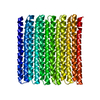 8ga7C 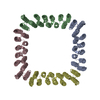 8gelC 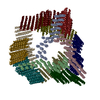 8tl7C 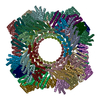 8v2dC M: atomic model generated by this map C: citing same article ( |
|---|
- Links
Links
| EMDB pages |  EMDB (EBI/PDBe) / EMDB (EBI/PDBe) /  EMDataResource EMDataResource |
|---|
- Map
Map
| File |  Download / File: emd_42944.map.gz / Format: CCP4 / Size: 178 MB / Type: IMAGE STORED AS FLOATING POINT NUMBER (4 BYTES) Download / File: emd_42944.map.gz / Format: CCP4 / Size: 178 MB / Type: IMAGE STORED AS FLOATING POINT NUMBER (4 BYTES) | ||||||||||||||||||||||||||||||||||||
|---|---|---|---|---|---|---|---|---|---|---|---|---|---|---|---|---|---|---|---|---|---|---|---|---|---|---|---|---|---|---|---|---|---|---|---|---|---|
| Annotation | deepEMhancer sharpened map | ||||||||||||||||||||||||||||||||||||
| Projections & slices | Image control
Images are generated by Spider. | ||||||||||||||||||||||||||||||||||||
| Voxel size | X=Y=Z: 1.86667 Å | ||||||||||||||||||||||||||||||||||||
| Density |
| ||||||||||||||||||||||||||||||||||||
| Symmetry | Space group: 1 | ||||||||||||||||||||||||||||||||||||
| Details | EMDB XML:
|
-Supplemental data
-Additional map: unsharpened map
| File | emd_42944_additional_1.map | ||||||||||||
|---|---|---|---|---|---|---|---|---|---|---|---|---|---|
| Annotation | unsharpened map | ||||||||||||
| Projections & Slices |
| ||||||||||||
| Density Histograms |
-Half map: half map A
| File | emd_42944_half_map_1.map | ||||||||||||
|---|---|---|---|---|---|---|---|---|---|---|---|---|---|
| Annotation | half map A | ||||||||||||
| Projections & Slices |
| ||||||||||||
| Density Histograms |
-Half map: half map B
| File | emd_42944_half_map_2.map | ||||||||||||
|---|---|---|---|---|---|---|---|---|---|---|---|---|---|
| Annotation | half map B | ||||||||||||
| Projections & Slices |
| ||||||||||||
| Density Histograms |
- Sample components
Sample components
-Entire : Computational Designed Nanocage O43_129_+4
| Entire | Name: Computational Designed Nanocage O43_129_+4 |
|---|---|
| Components |
|
-Supramolecule #1: Computational Designed Nanocage O43_129_+4
| Supramolecule | Name: Computational Designed Nanocage O43_129_+4 / type: complex / ID: 1 / Parent: 0 / Macromolecule list: all Details: Chain A and chain B were expressed separately in E. coli. Complex was formed by mixing the lysis of chain A and chain B. Sample was purified through HIS-tag on chain A. |
|---|---|
| Source (natural) | Organism: unidentified (others) |
-Macromolecule #1: O43_129_+4 component A
| Macromolecule | Name: O43_129_+4 component A / type: protein_or_peptide / ID: 1 / Number of copies: 24 / Enantiomer: LEVO |
|---|---|
| Source (natural) | Organism: synthetic construct (others) |
| Molecular weight | Theoretical: 33.976965 KDa |
| Recombinant expression | Organism:  |
| Sequence | String: MGCDAIQAAA ALGEAGISSN EILELLAAAA ELGLDPDAIQ AAAQLGEAGI SSEEIKELLR AAHELGLDPD AIAAAADLGQ AGVSPVEIL ALLIAASVLG LDPDAIQAAA ALGEAGISAE EIIELLTAAR DLGLDPDAIQ AAAQLGEAGI SSEEIKELLR A AHELGLDP ...String: MGCDAIQAAA ALGEAGISSN EILELLAAAA ELGLDPDAIQ AAAQLGEAGI SSEEIKELLR AAHELGLDPD AIAAAADLGQ AGVSPVEIL ALLIAASVLG LDPDAIQAAA ALGEAGISAE EIIELLTAAR DLGLDPDAIQ AAAQLGEAGI SSEEIKELLR A AHELGLDP DCIAAAADLG QAGISSSEIT ALLLAAAAIE LAKRADDKDV REIVRDALEL ASRSTNDEVI RLALEAAVLA AR STDSDVL EIVKDALELA KQSTNEEVIK LALKAAVLAA KSTDEEVLEE VKEALRRAKE STDEEEIKEE LRKAVEEAEG GSW LEHHHH HH |
-Macromolecule #2: O43_129_+4 component B
| Macromolecule | Name: O43_129_+4 component B / type: protein_or_peptide / ID: 2 / Number of copies: 24 / Enantiomer: LEVO |
|---|---|
| Source (natural) | Organism: synthetic construct (others) |
| Molecular weight | Theoretical: 46.675922 KDa |
| Recombinant expression | Organism:  |
| Sequence | String: MGDDLLLKLL ELLVEQARVS AEFARRQGDE KMLEEVARKA EEVARKAEEI ARKARKEGNL ELALKALEIL VRAAHVLAEI ARERGNEEL QKKAHKLAKE ALRQVIEIAI RAIQEGNLEL AIIALHISVR IAEVLLETRP DDREEIREQQ AIFELLIAAL E AAIRLEKL ...String: MGDDLLLKLL ELLVEQARVS AEFARRQGDE KMLEEVARKA EEVARKAEEI ARKARKEGNL ELALKALEIL VRAAHVLAEI ARERGNEEL QKKAHKLAKE ALRQVIEIAI RAIQEGNLEL AIIALHISVR IAEVLLETRP DDREEIREQQ AIFELLIAAL E AAIRLEKL KEEGAPPEQI ERVAEHGLER LKEIAKEISK EVDSPESKRI AYKIVAAAAE FLLKILAEGG ATPEQLERVT EH ALEVLKE VAKELADSPE SVREAVRLIS KLTQEGLKQL KEIGAPPEQI ERVAEHGLEV LKEIAKYGSK LTDSPELKRE LYR IISETA KELLKILAEG GATPEQLERV TKHALEVLKE VAKELADSPE SGLAALAAIA SLAKLGLEQL KEIGAPPEQQ RRVT KAGIE AVREIYRYGR KLY |
-Experimental details
-Structure determination
| Method | cryo EM |
|---|---|
 Processing Processing | single particle reconstruction |
| Aggregation state | particle |
- Sample preparation
Sample preparation
| Concentration | 0.8 mg/mL | |||||||||
|---|---|---|---|---|---|---|---|---|---|---|
| Buffer | pH: 8 Component:
Details: 300mM NaCl, 25mM Tris-HCL | |||||||||
| Vitrification | Cryogen name: ETHANE / Chamber humidity: 100 % / Chamber temperature: 295.15 K / Instrument: FEI VITROBOT MARK IV |
- Electron microscopy
Electron microscopy
| Microscope | FEI TITAN KRIOS |
|---|---|
| Image recording | Film or detector model: GATAN K3 (6k x 4k) / Average electron dose: 52.0 e/Å2 |
| Electron beam | Acceleration voltage: 300 kV / Electron source:  FIELD EMISSION GUN FIELD EMISSION GUN |
| Electron optics | Illumination mode: FLOOD BEAM / Imaging mode: BRIGHT FIELD / Cs: 2.7 mm / Nominal defocus max: 1.8 µm / Nominal defocus min: 0.8 µm |
| Experimental equipment |  Model: Titan Krios / Image courtesy: FEI Company |
+ Image processing
Image processing
-Atomic model buiding 1
| Details | Computationally designed model was docked into experimentally derived volume map in ChimeraX. It was then relaxed using Namdinator. Then it was trimmed to polyA in PHENIX. |
|---|---|
| Refinement | Space: REAL / Protocol: OTHER / Overall B value: 804.6 / Target criteria: Cross-correlation coefficient |
| Output model |  PDB-8v3b: |
 Movie
Movie Controller
Controller



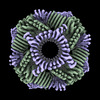












 Z (Sec.)
Z (Sec.) Y (Row.)
Y (Row.) X (Col.)
X (Col.)













































